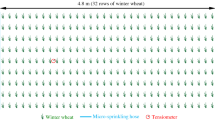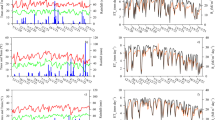Abstract
Based on evaporation from a 20 cm diameter pan placed above the crop canopy, sprinkler irrigation scheduling of winter wheat was studied in the North China Plain (NCP) in the 2001–2004 winter wheat seasons. Results showed that pan evaporation (E pan,C) was closely related to actual evapotranspiration (ET) measured using weighing lysimeters. The combined pan–crop coefficient (K c,pan), the ratio of ET to E pan,C, was closely related to leaf area index (LAI ) and plant height. Data from the 2002–2003 season were used to establish the relationships between K c,pan and LAI (method A) or plant height (method B), and used to determine the crop coefficient (method C). ET computed by the three methods was compared with measured ET using lysimeters in the 2001–2002 and 2003–2004 seasons. Mean relative error of estimated daily ET by the three methods ranged from 20 to 30%, and the relative error in cumulative ET in the experimental periods ranged from 1 to 19%. Among the three methods, results from methods A and B were not significantly different from each other (P > 0.01), and were closer to the lysimeter data than results from method C (P < 0.001). Method B, being easier to measure, was recommended for ET estimation in NCP.











Similar content being viewed by others
Abbreviations
- E pan :
-
evaporation from 20 cm pan (mm)
- E pan,C :
-
evaporation from 20 cm pan placed above the top of the canopy (mm)
- E pan,G :
-
evaporation from 20 cm pan at a meteorological station (mm)
- ET:
-
actual crop evapotranspiration (mm)
- ETmeasured :
-
ET measured using weighing lysimeters (mm)
- ETestimated :
-
ET estimated using models (mm)
- ET0 :
-
reference evapotranspiration calculated using FAO 56 Penman–Monteith method (mm)
- H :
-
plant height (m)
- H max :
-
maximal plant height in a winter wheat season (m)
- K c :
-
crop coefficient
- K c,pan :
-
combined pan–crop coefficient
- K p :
-
pan coefficient
- LAI:
-
leaf area index
- LAImax :
-
maximal leaf area index in a winter wheat season
- RE:
-
mean relative error
- W base :
-
base water amount each applied to a 20 cm pan (mm)
- W left :
-
water amount remaining in the 20 cm pan after a 24-h period of evaporation (mm)
- R :
-
rainfall (mm)
References
Al-Jamal MS, Ball S, Sammis TW (2001) Comparison of sprinkler, trickle, and furrow irrigation efficiencies for onion production. Agric Water Manage 46:253–266
Allen RG, Pereira LS, Raes D, Smith M (1998) Crop evapotranspiration: guidelines for computing crop water requirements. FAO Irrigation and Drainage Paper 56, FAO, Rome
Bai WM, Li LH (2003) Effect of irrigation methods and quota on root water uptake and biomass of alfalfa in the Wulanbuhe sandy region of China. Agric Water Manage 62:139–148
Bastug R, Buyuktas D (2003) The effects of different irrigation levels applied in golf courses on some quality characteristics of turfgrass. Irrig Sci 22:87–93
Byers PL, Moore JN (1987) Irrigation scheduling for young highbush blueberry plants in Arkansas. Hortscience 22(1):52–54
Cetin O, Bilgel L (2002) Effects of different irrigation methods on shedding and yield of cotton. Agric Water Manage 54:1–15
China Meteorological Administration (2005) General Meteorological stations in China. http://www.cma.gov.cn/netcenter_news/jcwl/tzxx/t20041105_42148.phtml
Ciolkosz DE, Albright LD (2000) Use of small-scale evaporation pans for evaluation of whole plant evapotranspiration. Trans ASAE 43(2):415–420
Gallardo M, Jackson LE, Schulbach K, Snyder RL, Thompson RB, Wyland LJ (1996) Production and water use in lettuces under variable water supply. Irrig Sci 16:125–137
Hang AN, Miller DE (1986) Yield and physiological responses of potatoes to deficit, high frequency sprinkler irrigation. Agron J 78:436–440
Heinemann B, Hoogenboom G, Georgiev GA, de Faria RT, Frizzone JA (2000) Center pivot irrigation management optimization of dry beans in humid areas. Trans ASAE 43(6):1507–1516
Home PG, Panda PK, Kar S (2002) Effect of method and scheduling of irrigation on water and nitrogen use efficiencies of Okra. Agric Water Manage 55:159–170
Imtiyaz M, Mgadla NP, Chepete B, Manase SK (2000) Response of six vegetable crops to irrigation schedules. Agric Water Manage 45:331–342
Kang Y, Liu HJ, Liu S, Lou J (2002) Effect of sprinkler irrigation on field microclimate. In: Proceedings of the 2002 ASAE Annual International Meeting/VX CIGR World Congress, ASAE Paper Number: 022285
Kohl RA, Wright JL (1974) Air temperature and vapor pressure changes caused by sprinkler irrigation. Agron J 66:85–87
Koumanov KS, Hopmans JW, Schwankl LJ, Andreu L, Tuli A (1997) Application efficiency of micro-sprinkler irrigation of almond trees. Agric Water Manage 34:247–263
Li J, Rao M (2000) Sprinkler water distributions as affected by winter wheat canopy. Irrig Sci 20:29–35
Liu Y, Costa S (1998) Reference evapotranspiration. In: Pereira LS, Musy A, Liang RJ, Hann M (eds) Water and soil management for sustainable agriculture in the North China Plain. ISA, Lisbon, pp 49–57
Liu Y, Teixeira JL, Zhang HJ, Pereira LS (1998) Model validation and crop coefficients for irrigation scheduling in the North China plain. Agric Water Manage 36:233–246
Liu C, Zhang X, Zhang Y (2002) Determination of daily evaporation and evapotranspiration of winter wheat and maize by large-scale weighing lysimeter and micro-lysimeter. Agric For Meteorol 111:109–120
Locascio SJ, Smajstrla AG (1996) Water application scheduling by pan evaporation for drip-irrigation tomato. J Am Soc Hortsci 121(1):63–68
Mao X, Liu M, Wang X, Liu C, Hou Z, Shi J (2003) Effects of deficit irrigation on yield and water use of greenhouse grown cucumber in the North China Plain. Agric Water Manage 61:219–228
Mateos L, Mantovani EC, Villalobos FJ (1997) Cotton response to non-uniformity of conventional sprinkler irrigation. Irrig Sci 17:47–52
Michelakis N, Vougioucalou E, Clapaki G (1993) Water use, wetted soil volume, root distribution and yield of avocado under drip irrigation. Agric Water Manage 24:11–131
Ministry of Water Resources and Electric Power, People’s Republic of China (1988) Standard of water surface evaporation measurement, Standard No. SD 265–88, Bei**g, China
Panigrahi B, Panda SN, Raghuwanshi NS (2001) Potato water use and yield under furrow irrigation. Irrig Sci 20:155–163
Pereira LS, Oweis T, Zairi A (2002) Irrigation management under water scarcity. Agric Water Manage 57:175–206
Schneider D, Howell TA (2001) Scheduling deficit wheat irrigation with data from an evapotranspiration network. Trans ASAE 44(6):1617–1623
Shalhevet J, Shimshi D, Meir T (1983) Potato irrigation requirement in a hot climate sprinkler and drip methods. Agron J 75:13–16
Singh R, Singh J (1996) Irrigation planning in cotton through simulation modeling. Irrig Sci 17:31–36
Singh S, Ram M, Ram D, Singh VP, Sharma S, Tajuddin (2000) Response of lemongrass (Cymbopogon flexuosus) under different levels of irrigation on deep sandy soils. Irrig Sci 20:15–21
Stanhill G (2002) Is the Class A evaporation pan still the most practical and accurate meteorological method for determining irrigation water requirements? Agric For Meteorol 112:233–236
Thomas DL, Harrison KA, Hook JE (2004) Sprinkler irrigation scheduling with the UGA easy pan: performance characteristics. Appl Eng Agric 20(4):439–445
Torres JS (1998) A simple visual aid for sugarcane irrigation scheduling. Agric Water Manage 38:77–83
Wang H, Zhang L, Dawes WR, Liu C (2002) Improving water use efficiency of irrigated crops in the North China Plain—measurements and modeling. Agric Water Manage 48:151–167
Yazar A, Metin Sezen S, Sesveren S (2002) LEPA and trickle irrigation of cotton in the Southeast Anatolia Project (GAP) area in Turkey. Agric Water Manage 54:189–203
Yuan B, Kang Y, Nishiyama S (2001) Drip irrigation scheduling for tomatoes in unheated greenhouses. Irrig Sci 20:149–154
Yuan B, Nishiyama S, Kang Y (2003) Effects of different irrigation regimes on the growth and yield of drip irrigated potato. Agric Water Manage 63(3):153–167
Yuan B, Sun J, Nishiyama S (2004) Effect of drip irrigation on strawberry growth and yield inside a plastic greenhouse. Biosyst Eng 87(2):237–245
Zhang H, Wang X, You M, Liu C (1999) Water–yield relations and water-use efficiency of winter wheat in the North China Plain. Irrig Sci 19:37–45
Zhang Y, Kendy E, Yu Q, Liu C, Shen Y, Sun H (2004) Effect of soil water deficit on evapotranspiration, crop yield, and water use efficiency in the North China Plain. Agric Water Manage 64:107–122
Acknowledgments
The authors gratefully acknowledge Prof. G. Huang, Y. Cohen, G. Stanhill and Dr. W.H. Kudzo Dorgbetor for helpful suggestions during the course of the study and paper revision and two anonymous reviewers for their helpful comments. The research is the part work of Project 40125002 supported by the National Fund for Distinguished Young Scholars, Project 50509025 supported by National Natural Science Foundation of China and Project WL2005003 supported by Key Lab of Water Cycle and Related Land Surface Process, Chinese Academy of Sciences.
Author information
Authors and Affiliations
Corresponding author
Additional information
Communicated by T. Trooien
Rights and permissions
About this article
Cite this article
Liu, HJ., Kang, Y. Sprinkler irrigation scheduling of winter wheat in the North China Plain using a 20 cm standard pan. Irrig Sci 25, 149–159 (2007). https://doi.org/10.1007/s00271-006-0042-z
Received:
Accepted:
Published:
Issue Date:
DOI: https://doi.org/10.1007/s00271-006-0042-z




